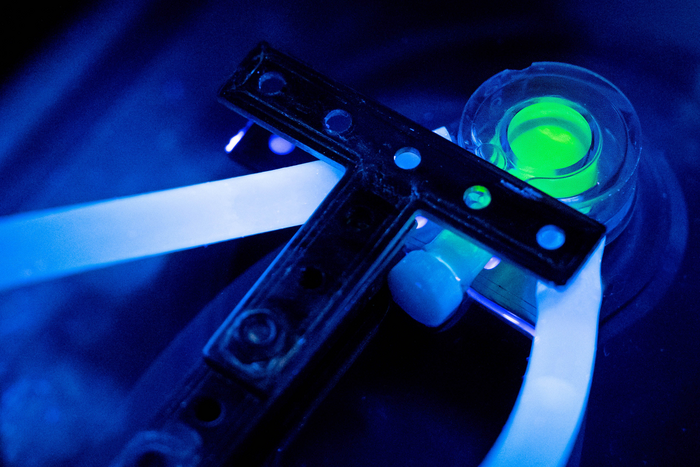Jena, Germany (17.06.2022) If mechanoluminescent materials are subjected to external mechanical stress, they emit visible or invisible light. Such excitation can occur due to bending or gentle pressure, for example, but also completely contact-free through ultrasound. In this way, the effect can be triggered remotely and light can be brought to places that normally tend to be in the dark, for example in the human body. If the ultrasound treatment is to be used at the same time to generate local heat, it is important in such a sensitive environment to observe closely the temperatures that occur. Material scientists at Friedrich Schiller University Jena, Germany have now developed a mechanoluminescent material that can not only be used to generate a local heat input by means of ultrasound, but also provides feedback on the local temperature at the same time. They report on their research results today in the scientific journal Advanced Science.

Credit: (Image: Jens Meyer/University of Jena)
Jena, Germany (17.06.2022) If mechanoluminescent materials are subjected to external mechanical stress, they emit visible or invisible light. Such excitation can occur due to bending or gentle pressure, for example, but also completely contact-free through ultrasound. In this way, the effect can be triggered remotely and light can be brought to places that normally tend to be in the dark, for example in the human body. If the ultrasound treatment is to be used at the same time to generate local heat, it is important in such a sensitive environment to observe closely the temperatures that occur. Material scientists at Friedrich Schiller University Jena, Germany have now developed a mechanoluminescent material that can not only be used to generate a local heat input by means of ultrasound, but also provides feedback on the local temperature at the same time. They report on their research results today in the scientific journal Advanced Science.
Semiconductors and rare earths
In their work, the Jena scientists often deal with the mechanical properties of inorganic materials, in particular with how one can observe mechanical processes optically.
“Mechanically induced light emission can provide us with many details about a material’s response to mechanical stress,” explains Prof. Lothar Wondraczek of the University of Jena. “But in order to expand the field of applications, it is sometimes also necessary to obtain additional information about the local temperature – especially when the excitation is carried out by means of ultrasound. Here, we were initially interested in sensor materials in the form of ultra-fine particles, which – introduced into the environment to be studied – can provide feedback information about how ultrasound interacts with this environment.”
For this purpose, the Jena researchers have combined an oxysulphide semiconductor with the rare earth erbium oxide. The semiconducting structure absorbs mechanical energy provided by ultrasound excitation, with the erbium oxide providing the light emission. The temperature can then be read from the spectrum of the emitted light by means of optical thermometry.
“This means that we can stimulate a temperature increase from the outside, measure it from the characteristics of light emission, and thus establish a complete control circuit,” explains Wondraczek.
Application in photodynamic therapy
The remote-controlled light emission, combined with temperature control, could open up completely new areas of application for such mechanoluminescent materials, for example in medicine. “One possible field of application could be photodynamic therapy, in which light is used to control photophysical processes that can support the organism in healing,” says materials scientist Wondraczek.
With multi-responsive mechanoluminescent materials in the form of very fine particles, not only could light and heat be generated at a desired location, but they could also be controlled in a targeted manner. As biological tissue is transparent to the infrared light emitted, it is possible to set and control a desired temperature from the outside during treatment. “However, such ideas are still very much in their infancy. Very extensive research and study are still needed in order to put them into practice.”
More accessible are other applications in which light and heat need to be brought to dark places in a targeted fashion. For example, photosynthesis or other light-driven reactions could be specifically triggered, observed and controlled. Likewise, going back to the beginning, the material can be used as a sensor for generating or observing material changes, or also as an invisible, coded marking on material surfaces.
Journal
Advanced Science
DOI
10.1002/advs.202201631
Method of Research
Experimental study
Article Title
Ultrasound-induced mechanoluminescence and optical thermometry toward stimulus-responsive materials with simultaneous trigger response and read-out functions
Article Publication Date
17-Jun-2022




